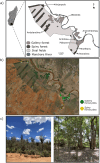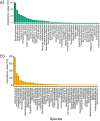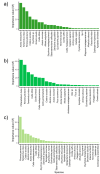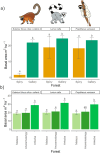Structural and compositional differences in gallery and spiny forests of Southern Madagascar: Implications for conservation of lemur and tree species
- PMID: 39208139
- PMCID: PMC11361438
- DOI: 10.1371/journal.pone.0307907
Structural and compositional differences in gallery and spiny forests of Southern Madagascar: Implications for conservation of lemur and tree species
Abstract
Madagascar's unique dry forests, particularly gallery and spiny forests, face severe threats and are significantly understudied, leaving only a fraction of the original extent intact. Thus, there is a critical need for characterizing, conserving, and restoring this diverse forest ecosystem. Conducting extensive floristic surveys and environmental analyses, we investigated structural and compositional differences between the gallery and spiny forests, as well as within distinct gallery forest sites in Berenty Reserve in the south of the island. We also evaluated differences in habitat quality between the spiny and gallery forests for three species of diurnal lemurs in the reserve, and analyzed the current population trend of the tamarind trees, a species of ecological and cultural importance in Madagascar. Our findings revealed that the spiny and gallery forests differed in composition and structure, confirming the unique ecological characteristics of gallery forests and the underexplored richness of spiny forests. Spiny forests exhibited higher species richness despite a comparatively lower sampling effort, emphasizing the need for focused conservation efforts in these overlooked ecosystems. Tamarind populations, vital for lemur nutrition, showed signs of inadequate regeneration suggesting a recruitment bottleneck, possibly due to factors like a lowering water table, brown lemur foraging habits, or shifts in environmental conditions. Urgent interventions, including enrichment plantations, were recommended to ensure the survival of this keystone species. Contrasting botanical and lemur-centric perspectives revealed that while spiny and gallery forests differed botanically, they offered comparable habitat quality for ring-tailed and sifaka lemurs. However, brown lemurs exhibit a preference for the gallery forest, highlighting the intricate relationship between plant composition and lemur habitat choices. Our study underscores the urgency of expanding our knowledge of Madagascar´s dry forests, and Berenty Reserve, as one of the few remaining protected areas with gallery and spiny forests, serves as a reference for future research in Madagascar's understudied ecosystems.
Copyright: © 2024 Mondragón-Botero et al. This is an open access article distributed under the terms of the Creative Commons Attribution License, which permits unrestricted use, distribution, and reproduction in any medium, provided the original author and source are credited.
Conflict of interest statement
The authors have declared that no competing interests exist.
Figures







References
-
- Vieilledent G, Grinand C, Rakotomalala FA, Ranaivosoa R, Rakotoarijaona J-R, Allnutt TF, et al. Combining global tree cover loss data with historical national forest cover maps to look at six decades of deforestation and forest fragmentation in Madagascar. Biol Conserv. 2018;222: 189–197. doi: 10.1016/j.biocon.2018.04.008 - DOI
-
- Razafindramanana J, Scobie K. Biodiversity, Ecosystem Services and the Conservation of Madagascar’s Dry Gallery Forests and Freshwater Ecosystems. Imperiled: The Encyclopedia of Conservation. Elsevier; 2022. pp. 167–177.
MeSH terms
LinkOut - more resources
Full Text Sources

